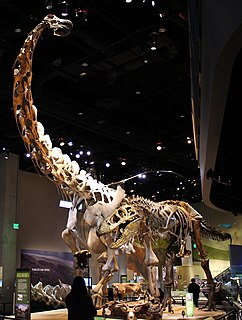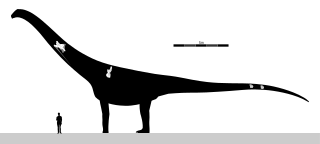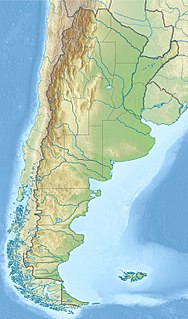
Argentinosaurus is a genus of giant sauropod dinosaur that lived during the Late Cretaceous period in what is now Argentina. Although it is only known from fragmentary remains, Argentinosaurus is one of the largest known land animals of all time, perhaps the largest, with length estimates ranging from 30 to 40 metres and weight estimates from 50 to 100 tonnes. It was a member of Titanosauria, the dominant group of sauropods during the Cretaceous.

Titanosaurs were a diverse group of sauropod dinosaurs, including genera from Africa, Asia, South America, North America, Europe, Australia and Antarctica. The titanosaurians were the last surviving group of long-necked sauropods, with taxa still thriving at the time of the extinction event at the end of the Cretaceous. This group includes some of the largest land animals known to have ever existed, such as Patagotitan—estimated at 37 m (121 ft) long with a weight of 69 tonnes —and the comparably-sized Argentinosaurus and Puertasaurus from the same region.

Antarctosaurus is a genus of titanosaurian sauropod dinosaur from the Late Cretaceous Period of what is now South America. The type species, Antarctosaurus wichmannianus, and a second species, Antarctosaurus giganteus, were described by prolific German paleontologist Friedrich von Huene in 1929. Three additional species of Antarctosaurus have been named since then but later studies have considered them dubious or unlikely to pertain to the genus.

Alamosaurus is a genus of potentially opisthocoelicaudiine titanosaurian sauropod dinosaurs, containing a single known species, Alamosaurus sanjuanensis, from the late Cretaceous Period of what is now southern North America. Isolated vertebrae and limb bones indicate that it reached sizes comparable to Argentinosaurus and Puertasaurus, which would make it the largest dinosaur known from North America. Its fossils have been recovered from a variety of rock formations spanning the Maastrichtian age of the late Cretaceous period. Specimens of a juvenile Alamosaurus sanjuanensis have been recovered from only a few meters below the Cretaceous-Paleogene boundary in Texas, making it among the last surviving non-avian dinosaur species.

Argyrosaurus is a genus of titanosaurian sauropod dinosaur that lived about 70 million years ago, during the Late Cretaceous Period of what is now Argentina.

Aeolosaurus is a genus of titanosaurian sauropod dinosaur from the Late Cretaceous Period of what is now South America. Like most sauropods, it would have been a quadrupedal herbivore with a long neck and tail. Aeolosaurus is well known for a titanosaur, as it is represented by the remains of several individuals belonging to at least three species. However, like most titanosaurs, no remains of the skull are known. The holotype of Aeolosaurus rionegrinus consists of a series of seven tail vertebrae, as well as parts of both forelimbs and the right hindlimb. It was discovered in the Angostura Colorada Formation in Argentina, which dates from the Campanian stage of the Late Cretaceous, about 83 to 74 million years ago. The species A. maximus was transferred over to the new genus Arrudatitan in 2021.
Andesaurus is a genus of basal titanosaurian sauropod dinosaur which existed during the middle of the Cretaceous Period in South America. Like most sauropods, it would have had a small head on the end of a long neck and an equally long tail. Andesaurus was a very large animal, as were many others of its relatives, which included the largest animals ever to walk the Earth.

Chubutisaurus is a genus of dinosaur from the Early Cretaceous Period. It lived in South America. It is classified as a sauropod, specifically one of the titanosaurs. The type species, Chubutisaurus insignis, was described by del Corro in 1975. Its fossils were found in the Cerro Barcino Formation, Albian stage, about 110 million years ago. Chubutisaurus had a more robust radius than Venenosaurus. In 2010 Gregory Paul gave a length of 18 meters (59 ft) and a weight of 12 tonnes. Thomas Holtz estimated its length at 23 meters (75.5 ft) in 2012.

Futalognkosaurus is a genus of titanosaurian dinosaur. The herbivorous Futalognkosaurus lived approximately 87 million years ago in the Portezuelo Formation, in what is now Argentina, of the Coniacian stage of the late Cretaceous Period. The fish and fossilized leaf debris on the site, together with other dinosaur remains, suggest a warm tropical climate in Patagonia during this period.
Gobititan is a genus of herbivorous sauropod dinosaur from the Barremian faunal stage of the Early Cretaceous, approximately 129-125 million years ago. The name of this genus is derived from the Gobi desert region and the Titans of Greek mythology, which is a reference to its large body size. The specific name shenzhouensis, is derived from "Shenzhou", an ancient name for China.

Rinconsaurus is a genus of titanosaur sauropod dinosaur from the Late Cretaceous in what is now Argentina. The type species, Rinconsaurus caudamirus, was described by Calvo and Riga in 2003, and is based on three partial skeletons.

Puertasaurus is a genus of sauropod dinosaur that lived in South America during the Late Cretaceous Period. It is known from a single specimen recovered from sedimentary rocks of the Cerro Fortaleza Formation in southwestern Patagonia, Argentina, which probably is Campanian or Maastrichtian in age. The only species is Puertasaurus reuili. Described by the paleontologist Fernando Novas and colleagues in 2005, it was named in honor of Pablo Puerta and Santiago Reuil, who discovered and prepared the specimen. It consists of four well-preserved vertebrae, including one cervical, one dorsal, and two caudal vertebrae. Puertasaurus is a member of Titanosauria, the dominant group of sauropods during the Cretaceous.
Malarguesaurus is a genus of titanosauriform sauropod dinosaur from the Late Cretaceous of Mendoza Province, Argentina. Its fossils, consisting of tail vertebrae, chevrons, ribs, and limb bones, were found in the early to middle Coniacian-aged Los Bastos Formation of the Neuquén Group. The type species, described by González Riga et al. in 2008, is M. florenciae.

Ruyangosaurus is a genus of titanosauriform sauropod dinosaur recovered from the Early Cretaceous Haoling Formation of China. The type species is R. giganteus, described in 2009 by Lü Junchang et al.

Lognkosauria is a group of giant long-necked sauropod dinosaurs within the clade Titanosauria. It includes some of the largest and heaviest dinosaurs known.

Quetecsaurus is a genus of titanosaurian sauropod dinosaur known from the Late Cretaceous of the southern Mendoza Province, western Argentina. It contains a single species, Quetecsaurus rusconii.

Notocolossus is a genus of titanosaurian sauropod dinosaur from late Cretaceous strata of Mendoza Province, Argentina.

Bernardo Javier González Riga is an Argentinean paleontologist; he is internationally recognised for his research on sauropod dinosaur evolution, and was awarded in 2019. He discovered in the Late Cretaceous strata of the Mendoza Province (Argentina) the huge sauropod dinosaur Notocolossus, one of the largest land animals ever found. He also described and co-described more than 10 new dinosaur species.

Rinconsauria is an extinct clade of giant titanosaurian sauropods known from the late Cretaceous period of Argentina.

The Sierra Barrosa Formation is a geologic formation of the Neuquén Basin in the northern Patagonian provinces of Mendoza and Neuquén. The formation dates to the Late Cretaceous, middle to late Coniacian, and belongs to the Río Neuquén Subgroup of the Neuquén Group. The formation overlies the Los Bastos Formation and is overlain by the Plottier Formation. As the underlying Los Bastos Formation, the Sierra Barrosa Formation comprises mudstones and sandstones deposited in a fluvial environment.




























